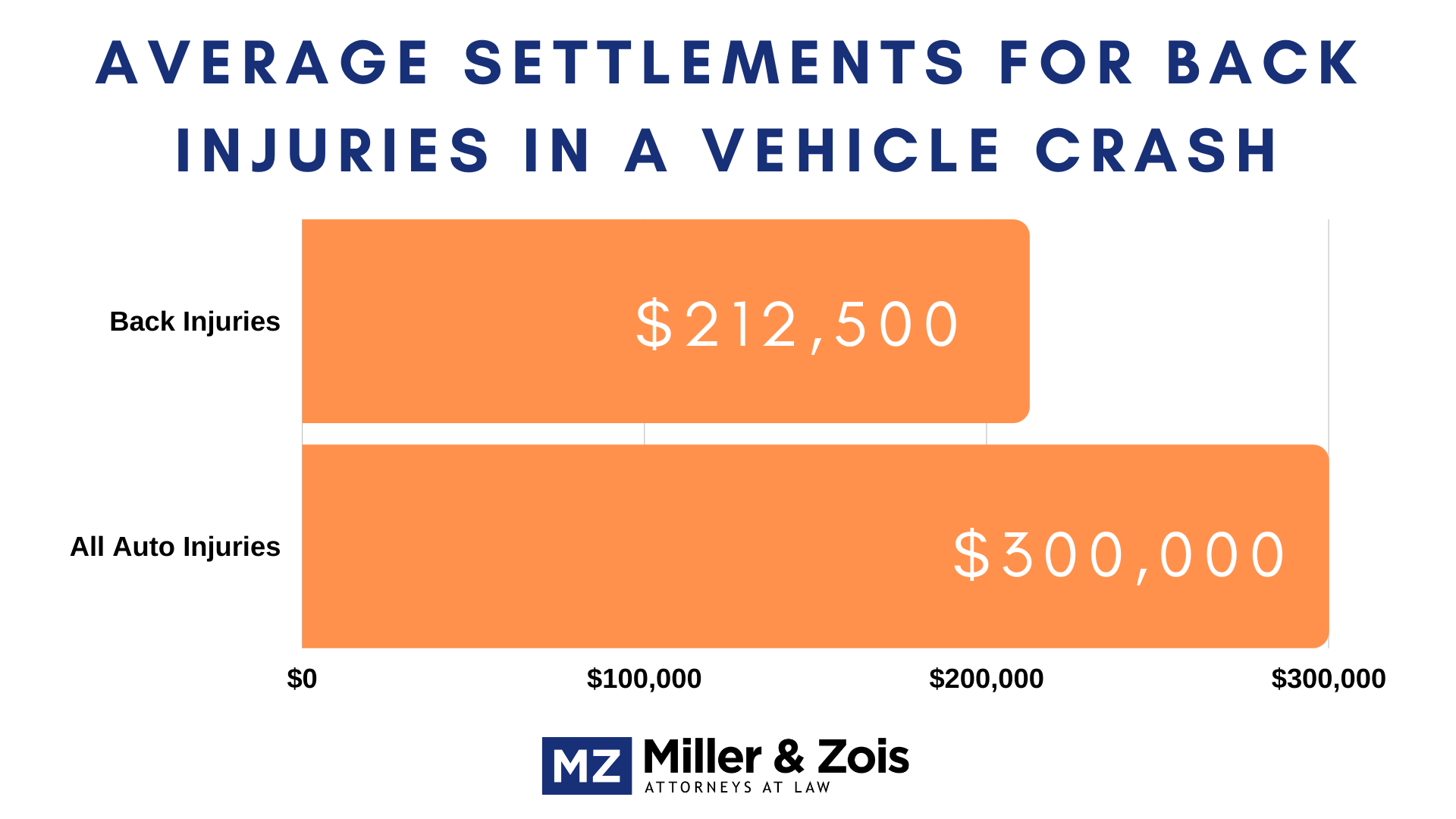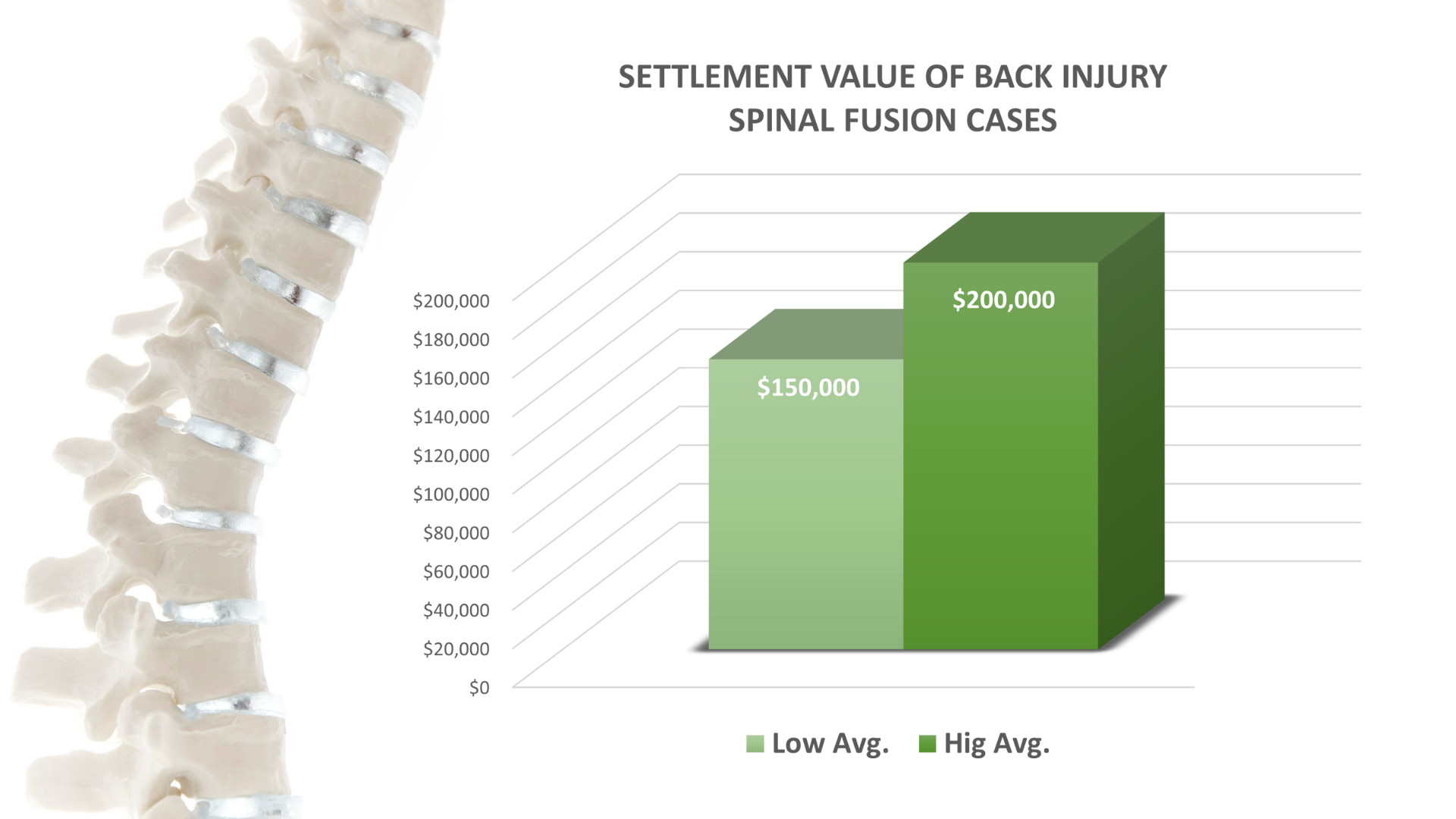In this post, we will look at personal injury cases in which the plaintiff is seeking compensation for an injury requiring spinal fusion surgery. Spinal fusion is a common treatment method for certain types of back injuries. When a plaintiff with a back injury undergoes spinal fusion surgery, it can greatly increase the compensation payout in their lawsuit.
Back Injuries in Personal Injury Lawsuits
Injuries to the back are exceedingly common in personal injury lawsuits, especially auto accident cases. Back injuries in tort cases can be grouped into 3 categories or levels based on the general severity of the injury.
| LEVEL 1 |
Level 1 back injuries are the least serious and generally involve soft tissue damage with no permanent impairment. The most common Level 1 back injuries in auto accident cases are whiplash and back sprains.
|
| LEVEL 2 |
Level 2 back injuries are more serious and usually require more extensive medical treatment. Common Level 2 back injuries include things like disc herniation and pinched nerves. Level 2 injuries can sometimes involve permanent impairment.
|
| LEVEL 3 |
Level 3 back injuries are the most severe and can often result in permanent impairment or disability. Spinal fractures and dislocated vertebrae are examples of Level 3 back injuries. These usually only occur in high-speed accidents. |
Settlement Payouts in Back Injury Cases
The settlement payout for a back injury in an auto accident case is largely dependent on the level of injury and the level of medical treatment it requires. The more extensive the plaintiff’s medical treatment for a back injury, the more financial compensation they will be entitled to in a lawsuit. Just like back injuries fall into levels of severity, treatment options for back injuries can also be grouped into 3 levels.
| LEVEL 1:
Medication & Therapy |
The first level of treatment for almost any back injury is always some type of anti-inflammatory medication for pain management combined with physical therapy.
|
| LEVEL 2:
Steroid Injections |
When pain medication and therapy do not eliminate the chronic pain of a back injury, the next level of medical treatment is epidural steroid injections. The injection of steroids into the epidural space of the spine can reduce inflammation and thereby alleviate pain.
|
| LEVEL 3:
Spinal Fusion Surgery |
If the first 2 levels of treatment are not successful, the third and final level of treatment for chronic pain related to a back injury is spinal fusion surgery. |

What is Spinal Fusion Surgery?
Spinal fusion is a type of back surgery that is utilized in the treatment of chronic pain from back injuries or degenerative conditions. In spinal fusion, vertebrae bones in the spine are surgically fused or joined together to form a single bone. Fusion of the vertebrae bones helps to reduce back pain by preventing the bones from moving independently.
Fusing the bones together is highly effective at eliminating back pain because it eliminates movement and pinching of adjacent nerves that are the source of the pain. The independent motion of the vertebrae bones is usually the primary source of pain related to back injuries. Fusion surgery seeks to eliminate this by immobilizing the bones.
Spinal fusion surgery is only an option when pain is being caused by the movement of the vertebrae bones and the source of the pain is known. Common accident-related back injuries that can be treated with spinal fusion include pinched nerves, herniated discs, spinal stenosis, and others.
Impact of Spinal Fusion Surgery on Compensation Payout
Reimbursement for medical expenses is always a major component of money damages in a personal injury case. This means that the more medical treatment and procedures a plaintiff undergoes, the more damages they will be entitled to. Whenever a plaintiff undergoes surgery it will significantly increase the amount of their medical damages because surgical procedures are very expensive. This is particularly true in back injury cases involving spinal fusion surgery.
When a plaintiff in a back injury case undergoes spinal fusion surgery as part of their treatment, it will usually double or triple the potential settlement payout value of their case. Spinal fusion surgery is expensive, so it will significantly increase the amount of medical expenses in the case.
The other reason spinal fusion surgery can boost the settlement value of a back injury case is that undergoing a surgical procedure automatically tends to validate the validity of the plaintiff’s pain & suffering claims. When the plaintiff only undergoes Level 1 or Level 2 treatment for a back injury, insurance adjusters and jurors tend to be more dismissive of pain & suffering allegations. When a plaintiff’s injury requires fusion surgery, however, the injury and resulting pain are viewed much differently and given more credit.

Verdicts & Settlements: Spinal Fusion Cases
Below are summaries of verdicts and reported settlements in recent cases in which the plaintiff received compensation after undergoing spinal fusion surgery.
- $43,131 Verdict (Pennsylvania 2022): vehicle accident caused plaintiff to suffer cervical disc injury which eventually required vertebra fusion surgery to treat.
- $580,923 Verdict (Wisconsin 2022): left turn accident involving a postal truck alleged caused C5-C6 disc damage which required discetomy and spinal fusion surgery with placement of a titanium plant and screws.
- $695,000 Settlement (Washington 2021): in addition to knee injury, plaintiff suffered back injury from collision which was initially treated with steroid injections and eventually with two-level spinal fusion surgery
- $100,000 Settlement (New York 2021): 14-year-old plaintiff suffered numerous injuries including back injuries that required spinal fusion surgery.
- $1,135,346 Verdict (Washington 2020): middle-aged woman received $1.1 for back injuries requiring spinal fusion surgery and for traumatic brain injury in a multi-car accident on the highway.
- $700,000 Settlement (California 2020): side-impact collision resulted in rib fractures, disc herniations, and spinal stenosis required spinal injections and eventually fusion surgery.
- $1,250,000 Settlement (California 2020): sternum fracture, lumbar herniation, cervical herniation, and shoulder impingements required injections and double spinal fusion surgery.
- $1,051,800 Verdict (Georgia 2020): mid-level injuries to the neck and back from rear-end accident required cervical discectomy and spinal fusion surgery.
- $2,300,000 Settlement (Florida 2019): 52-year old man underwent cervical and lumbar spinal fusion surgery to treat injuries to his lower back and neck which left him unable to work.
- $270,000 Settlement (Wisconsin 2019): middle-aged female suffered herniated discs in cervical spine and underwent extensive treatment including two-level cervical spinal fusion surgery.
How much money can you get from a spinal fusion surgery lawsuit settlement?
The average settlement money for a spinal fusion surgery lawsuit is between $150,000 and $200,000. The actual value of many cases may be limited the limits of the defendant’s liability insurance.
Will spinal fusion surgery increase my settlement?
Yes. Surgery will always increase the amount of a personal injury settlement because medical expenses are a main component of damages. In back injury cases, spinal fusion also adds validity to pain and suffering claims.
Is spinal fusion surgery effective?
Spinal fusion surgery is highly effective for certain types of back injuries, but it may be less effective for other types of injuries or conditions.
How long is the recovery time after spinal fusion surgery?
Spinal fusion surgery has a relatively long post-surgical recovery period. It can take anywhere from 4-6 weeks before normal movement and function is possible.
Can you mess up a spinal fusion?
Yes. The fusion between vertebrae bones can be broken or damaged after the surgery. This can result from another injury or from chronic conditions and other things.





